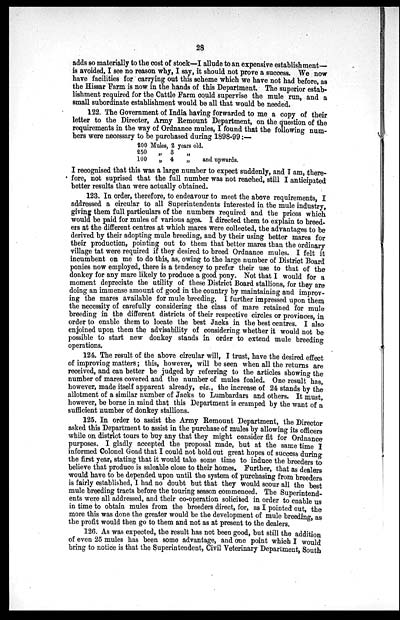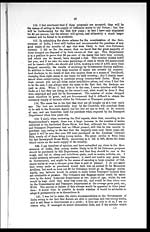Medicine - Veterinary > Civil Veterinary Departments > Annual administration report of the Civil Veterinary Department of India > 1898-1899 > Part I - Imperial report
(47) Page 28
Download files
Individual page:
Thumbnail gallery: Grid view | List view

28
adds so materially to the cost of stock—I allude to an expensive establishment—
is avoided, I see no reason why, I say, it should not prove a success. We now
have facilities for carrying out this scheme which we have not had before, as
the Hissar Farm is now in the hands of this Department. The superior estab-
lishment required for the Cattle Farm could supervise the mule run, and a
small subordinate establishment would be all that would be needed.
122. The Government of India having forwarded to me a copy of their
letter to the Directer, Army Remount Department, on the question of the
requirements in the way of Ordnance mules, I found that the following num-
bers were necessary to be purchased during 1898-99:—
|
200 Mules, 2 years old. |
|
|
250 „ 3 „ |
|
|
100 „ 4 „ |
and upwards. |
I recognised that this was a large number to expect suddenly, and I am, there-
fore, not suprised that the full number was not reached, still I anticipated
better results than were actually obtained.
123. In order, therefore, to endeavour to meet the above requirements, I
addressed a circular to all Superintendents interested in the mule industry,
giving them full particulars of the numbers required and the prices which
would be paid for mules of various ages. I directed them to explain to breed-
ers at the different centres at which mares were collected, the advantages to be
derived by their adopting mule breeding, and by their using better mares for
their production, pointing out to them that better mares than the ordinary
village tat were required if they desired to breed Ordnance mules. I felt it
incumbent on me to do this, as, owing to the large number of District Board
ponies now employed, there is a tendency to prefer their use to that of the
donkey for any mare likely to produce a good pony. Not that I would for a
moment depreciate the utility of these District Board stallions, for they are
doing an immense amount of good in the country by maintaining and improv-
ing the mares available for mule breeding. I further impressed upon them
the necessity of carefully considering the class of mare retained for mule
breeding in the different districts of their respective circles or provinces, in
order to enable them to locate the best Jacks in the best centres. I also
enjoined upon them the advisability of considering whether it would not be
possible to start new donkey stands in order to extend mule breeding
operations.
124. The result of the above circular will, I trust, have the desired effect
of improving matters; this, however, will be seen when all the returns are
received, and can better be judged by referring to the articles showing the
number of mares covered and the number of mules foaled. One result has,
however, made itself apparent already, viz., the increase of 24 stands by the
allotment of a similar number of Jacks to Lumbardars and others. It must,
however, be borne in mind that this Department is cramped by the want of a
sufficient number of donkey stallions.
125. In order to assist the Army Remount Department, the Director
asked this Department to assist in the purchase of mules by allowing its officers
while on district tours to buy any that they might consider fit for Ordnance
purposes. I gladly accepted the proposal made, but at the same time I
informed Colonel Goad that I could not hold out great hopes of success during
the first year, stating that it would take some time to induce the breeders to
believe that produce is saleable close to their homes. Further, that as dealers
would have to be depended upon until the system of purchasing from breeders
is fairly established, I had no doubt but that they would scour all the best
mule breeding tracts before the touring season commenced. The Superintend-
ents were all addressed, and their co-operation solicited in order to enable us
in time to obtain mules from the breeders direct, for, as I pointed out, the
more this was done the greater would be the development of mule breeding, as
the profit would then go to them and not as at present to the dealers.
126. As was expected, the result has not been good, but still the addition
of even 25 mules has been some advantage, and one point which I would
bring to notice is that the Superintendent, Civil Veterinary Department, South
Set display mode to: Large image | Zoom image | Transcription
Images and transcriptions on this page, including medium image downloads, may be used under the Creative Commons Attribution 4.0 International Licence unless otherwise stated. ![]()
| India Papers > Medicine - Veterinary > Civil Veterinary Departments > Annual administration report of the Civil Veterinary Department of India > 1898-1899 > Imperial report > (47) Page 28 |
|---|
| Permanent URL | https://digital.nls.uk/75506334 |
|---|




